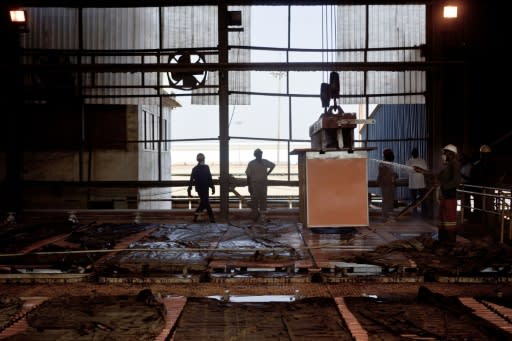Canadian miner to launch major copper project in DR Congo
21/10/2015
Despite tumbling commodity prices, Canada's Ivanhoe Mines (Other OTC: IVPAF - news) says copper production at a new giant deposit in the Democratic Republic of Congo should start in 2018, as it eyes a future deficit in the market and rising global demand.
The discovery at Kamoa in the southeast of the vast mineral-rich country has been presented as one of the biggest finds in copper mining in many years, though DR Congo is already Africa's top copper producer and one of the world leaders.
"We think we can begin production at the end of 2018," Louis Watum, the head of Ivanhoe DRC, told a recent mining conference in Kinshasa.
But in the commodities market, mining companies have been struck by a sharp fall in prices, affected by the economic slowdown in top consumer China.
Swiss mining giant Glencore (Xetra: A1JAGV - news) , with a mountain of $30 billion in debt, recently suspended production for 18 months in one of DR Congo's biggest copper mines.
Watum, however, believes conditions should favour the launch of the Kamoa mine, which lies about 25 kilometres (15 miles) west of the major mining town of Kolwezi in the Katanga copper belt.
"Even (Taiwan OTC: 6436.TWO - news) if China is running out of steam or slowing down today, other countries are still asking for copper. So in the two or three years (to come) we can easily foresee a deficit of copper on the market just as we go into production," Watum said.
Ivanhoe Mines estimates that the deposit, found in 2007, contains the equivalent of at least 45 million tonnes of pure copper. The company aims to extract 300,000 tonnes per year once production reaches a peak.
- Chinese co-developer -
The Canadian firm, which has a 95 percent stake in the Kamoa project, announced in May that it had cut a deal with the Chinese group Zijin Mining (HKSE: 2899-OL.HK - news) to acquire, through a subsidiary, 49.5 percent of its holdings in exchange for $412 million (363 million euros).
Zijin also holds an option to acquire an additional 1.0 percent share upon successfully arranging project financing for 65 percent of the first phase of Kamoa's development costs.
"This agreement with Zijin, one of the world's most accomplished miners, is further confirmation of Kamoa's distinction as one of the most significant, undeveloped mineral discoveries of our age... Together with the Congolese government and Zijin, we aim to meet the expectations of the Congolese people and our stakeholders in Katanga as we proceed to build a world-class, new copper mine," Robert Friedland, Ivanhoe executive chairman, had said in a statement announcing the deal.
Ivanhoe has so far invested approximately $337 million in equity capital in discovering and developing the Kamoa project, the statement added.
But initially the deal with a Chinese co-developer met with disapproval in Kinshasa.
The Congolese state, which owns the remaining five percent of Kamoa Copper, had refused to approve the deal on the grounds that it had not been consulted.
A deadlock was broken at the end of September, when Kinshasa gave its green light after agreeing with Ivanhoe that the state's share could rise to 20 percent.
- Restoring vital rail link -
Mining is the driving force behind the country's annual rise in economic growth of more than seven percent since 2012, but the sector is frequently criticised for its lack of transparency. The dire poverty that prevails in DR Congo bears witness to great inequality in the distribution of wealth.
Mining groups operating in DR Congo also face power shortages and a lack of vital infrastructure, which has been allowed to persist by successive regimes since independence from Belgium in 1960.
To undertake the Kamoa project successfully, Ivanhoe Mines has joined forces with the National Company for Electricity to renovate two hydroelectric power plants.
Watum also said Ivanhoe is counting on the renovation of a railway line that passes through Kolwezi and heads west across central Angola to the Atlantic port of Lobito, a distance of more than 1,700 kilometres.
The Angolan railway was left in disrepair during a prolonged civil war and mining firms in Katanga have been exporting copper mainly over vast road distances to ports in South Africa and Tanzania.
The Congolese Chamber of Mines has announced that in 2015, it does not expect copper production to reach last year's record of more than one million tonnes. It (Other OTC: ITGL - news) estimates that production will attain a little more than 974,000 tonnes (Other OTC: UBGXF - news) .

No comments:
Post a Comment